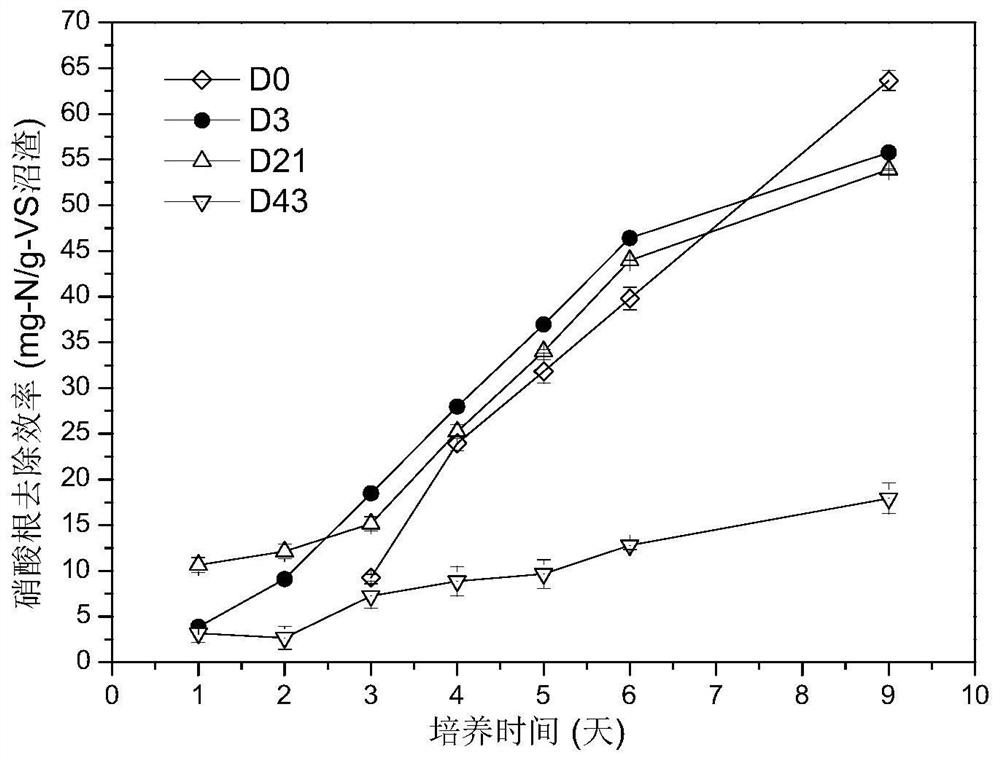Biogas residue biological stability rapid test method and system
A technology of biological stability and testing method, which is applied in the field of quick testing of biological stability of biogas residues, can solve the problems of mold breeding test results, test timeliness defects, uneven gas-solid mass transfer, etc., so as to save test time and be highly repeatable property, and the effect of increasing the reaction rate
- Summary
- Abstract
- Description
- Claims
- Application Information
AI Technical Summary
Problems solved by technology
Method used
Image
Examples
Embodiment 1
[0042] The rapid test device for the biological stability of biogas residues in this embodiment includes a culture bottle 1 , a lye absorption bottle 7 , a gas flow meter 8 , a relay 10 and a metering pump 4 , wherein the biogas residue sample 2 is filled in the culture bottle 1 . The lye absorption bottle 7 is connected with the culture bottle 1, and the nitrogen produced in the culture bottle 1 is according to figure 1 The nitrogen flow direction 6 in the flow flows to the lye absorption bottle 7. Gas flowmeter 8 is connected with described lye absorption bottle 7. The relay 10 is electrically connected with the gas flow meter 8 and receives the electrical signal sent by the gas flow meter 8 . The filling pump 4 is a metering pump, and its input end of the metering pump is connected to the KNO 3 The output end of the solution storage tank is connected to the culture bottle 1 , and the metering pump is electrically connected to the relay 10 . The metering pump is provided ...
Embodiment 2
[0046] Take the biogas residue produced in the catering waste batch anaerobic digestion reactor for 3 days, and record it as D3. Adjust the solid content of biogas residue to 5%, inject the biogas residue with adjusted solid content into culture bottle 1, and add 2mol / L KNO 3 solution into the culture bottle 1, so that the concentration of nitrate in the biogas residue is 250mg-N / L. After replacing the headspace of the culture bottle 1 with helium, the culture bottle 1 was placed in an incubator at 20° C. and 150 rpm for cultivation. The schematic diagram of the rapid evaluation biogas residue stability test system is as follows: figure 1 shown.
[0047]After 216 hours of cultivation, the corresponding nitrate removal efficiency of the D3 reactor was 55.8±0.4 mg-N / g-VS, (VS was calculated as the volatile solids of the initial biogas residue).
Embodiment 3
[0049] Take the biogas residue produced in the catering waste batch anaerobic digestion reactor on day 21 and day 43, and record it as D21. Adjust the solid content of biogas residue to 5%, inject the biogas residue with adjusted solid content into culture bottle 1, and add 2mol / L KNO 3 solution into the culture bottle 1, so that the concentration of nitrate in the biogas residue is 250mg-N / L. After replacing the headspace of the culture bottle 1 with helium, the culture bottle 1 was placed in an incubator at 20° C. and 150 rpm for cultivation. The schematic diagram of the rapid evaluation biogas residue stability test system is as follows: figure 1 shown. After 216 hours of cultivation, the corresponding nitrate removal efficiency of the D21 reactor was 53.9±0.1 mg-N / g-VS (VS was calculated as the volatile solids of the initial biogas residue).
PUM
| Property | Measurement | Unit |
|---|---|---|
| concentration | aaaaa | aaaaa |
Abstract
Description
Claims
Application Information
 Login to View More
Login to View More - R&D
- Intellectual Property
- Life Sciences
- Materials
- Tech Scout
- Unparalleled Data Quality
- Higher Quality Content
- 60% Fewer Hallucinations
Browse by: Latest US Patents, China's latest patents, Technical Efficacy Thesaurus, Application Domain, Technology Topic, Popular Technical Reports.
© 2025 PatSnap. All rights reserved.Legal|Privacy policy|Modern Slavery Act Transparency Statement|Sitemap|About US| Contact US: help@patsnap.com


